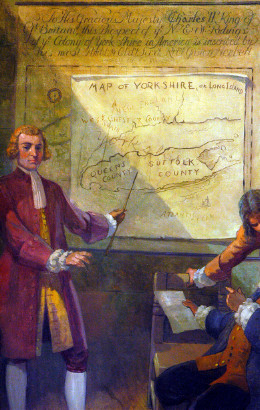2006 January
About Andrew Cusack
 Writer, web designer, etc.; born in New York; educated in Argentina, Scotland, and South Africa; now based in London.
Writer, web designer, etc.; born in New York; educated in Argentina, Scotland, and South Africa; now based in London. read more
News
Blogs
Reviews & Periodicals
Arts & Design
World
France
Mitteleuropa
Knickerbockers
Argentina
The Levant
Africa
Cape of Good Hope
Netherlands
Scandinavia
Québec
India
Muscovy
Germany
Academica
New York in the Early Republic
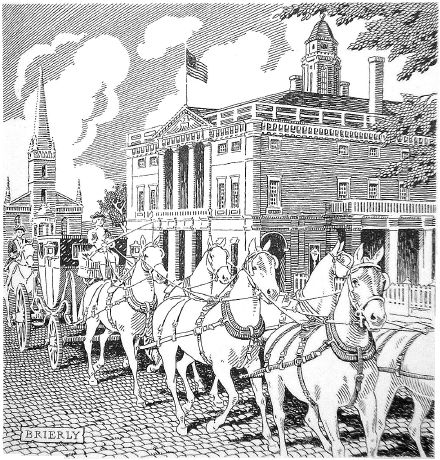
IT IS NOT OFTEN remembered that New York was the first capital of the United States and, as such, was home to the executive, legislative, and judicial branches of the new republic, albeit only for a short time. Federal Hall (above, with the Presidential carriage) was originally constructed in 1699 as a City Hall for New York. It was in this building at 26 Wall Street in 1735 that John Peter Zenger was tried and acquitted of libeling the Governor, affirming the Freedom of the Press. The Continental Congress began meeting in the City Hall in the 1780’s, and with the ratification of the new Constitution of the United States it became the first home of the federal government. Having been elected the first President of the United States, General George Washington was inaugurated on the balcony of the building on April 30, 1789. (more…)
Fresh Kills

Hail, rustic metropolis! I’d file this view of Fresh Kills on Staten Island under ‘You’d Never Believe You’re In New York City‘. The name might seem odd to those who aren’t either New Yorkers or Dutch. ‘Kill’ is a common placename in the Empire State, from the Middle Dutch ‘kille’ meaning riverbank or channel of water. Exempli gratia Arthur Kill, Kill van Kull, Fishkill, and Peekskill in New York, or the Schuykill River in Pennsylvania.
Previously: Rowing in Pelham Bay
How Sensitive the Constabulary are About Their Equine Colleagues!
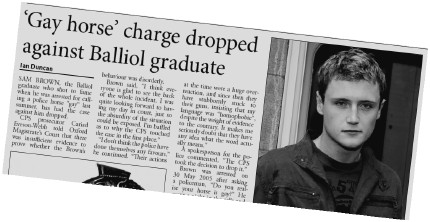
The famous ‘gay horse’ case, in which an Oxford student was being prosecuted for calling a policeman’s horse ‘gay’ at a protest, has been dropped. Even Peter Tatchell, the noxious and himself outrageous head of the outrageous group OutRage!, though the case was outrageous, commenting “The idea that saying a police horse is gay is homophobic is laughable. It brings the police into disrepute.”
‘Gay horse’ case dropped (The Scotsman, Edinburgh)
Case dropped against ‘gay horse’ student (Cherwell, Oxon)
The Restitution of Romanian Castles
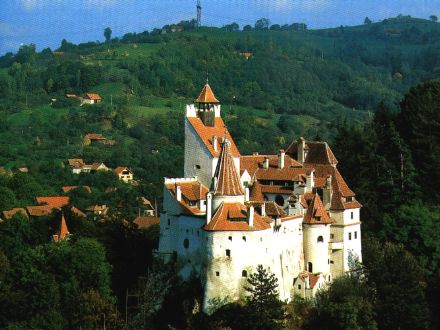
The castle of Bran (above), and the castles of Peles (below), and Pelisor (bottom) are to be restituted by the Romanian government to the Habsburgs and the Hohenzollern-Sigmaringens respectively, and then purchased back by the government for over $60 million, according to Adrian Iorgulescu, the Romanian Minister of Culture. The castles were illegitimately seized by the Communist authorities after they took power in 1947, and after buying them back the government will keep the castles as museums.
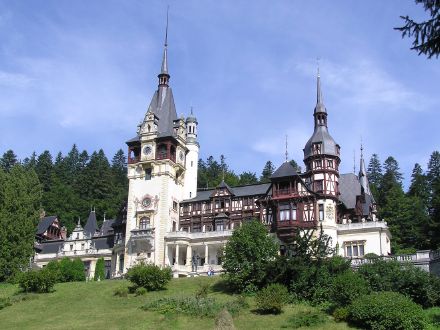
The Habsurgs are the Imperial Family of Austria as well as being the Royal Family of Hungary, Bohemia, Dalmatia, Croatia, Slavonia, Galicia, Lodomeria, Illyria, and Jerusalem, and the Ducal Family of Tuscany, Krakow, Lorraine, Salzburg, Styria, Carinthia, Carniola, the Bukovina, Transylvania, Upper Silesia, Lower Silesia, Modena, Parma, Piacenza, Guastalla, Auschwitz, Zator, Teschen, Friuli, Ragusa, and Zara. The Hohenzollern-Sigmaringen family, on the other hand, are a cadet branch of the senior Swabian branch of the Hohenzollerns, and are the Royal Family of Romania, which has been a republic since the Communist takeover in 1947 and has since, sadly, failed to restore its monarchy. Unlike the more reknowned Hohenzollerns of Brandenburg, the Romanian Royal Family are not Protestant.
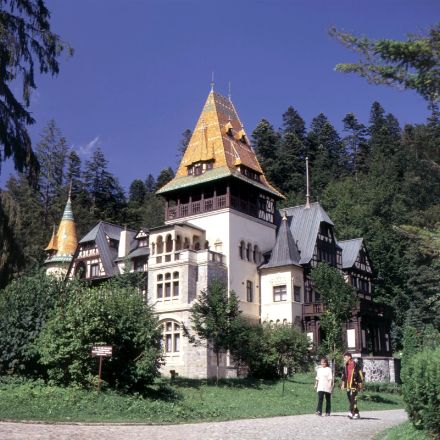
UPDATE: A reader corrects: “The Hohenzollern-Sigmaringens are not the cadet branch, but in fact the surviving senior branch, which position they inherited upon the extinction in the male line of the true senior line, the Hohenzollern-Hechingens, in 1869. Historically they are of minor importance in comparison to their apostate cousins, but still a storied family. Schloss Sigmaringen, by the way, is a magnificent seat, romantically restored in the 19th century. They own it still, but do not tend to live within its forbidding walls. I was shown round it once in dead of winter: an unforgettable experience.”
The Queen Mother in New York, 1954
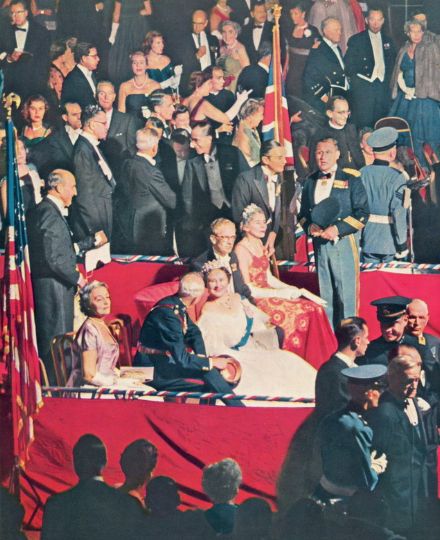
In 1954 Queen Elizabeth, the Queen Mother (n.1900, m.2002) visited New York to accept an educational fund raised by Americans in memory of the late King George VI. On the evening of November 1 of that year, the Seventh Regiment entertained Her Majesty with a special ball held in her honor at the Armory on Park Avenue (view above). Her Majesty also visited the Cathedral of St. John the Divine where she was received by the (Episcopal) Bishop of New York, the Dean, and the clergy of the Cathedral. The three stone blocks on the façade seen in the view below have since been sculpted.
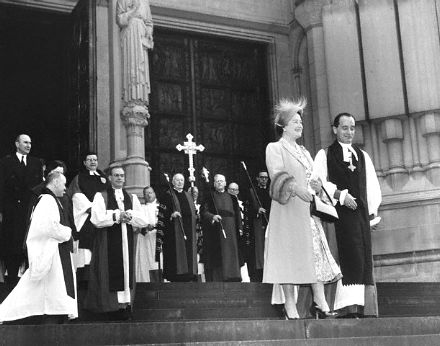
The Last Will and Testament of Louis XVI
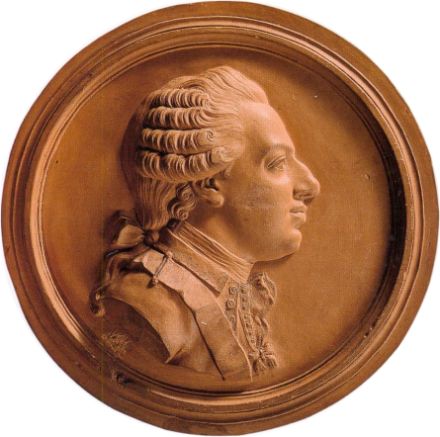
January 21 marked the anniversary of the regicide of Louis XVI, King of France, by the revolutionary authorities. Here is his last will and testament, written a month previous on Christmas Day.
In the name of the Very holy Trinity, Father, Son and Holy Ghost.
To-day, the 25th day of December, 1792, I, Louis XVI King of France, being for more than four months imprisoned with my family in the tower of the Temple at Paris, by those who were my subjects, and deprived of all communication whatsoever, even with my family, since the eleventh instant; moreover, involved in a trial the end of which it is impossible to foresee, on account of the passions of men, and for which one can find neither pretext nor means in any existing law, and having no other witnesses, for my thoughts than God to whom I can address myself, I hereby declare, in His presence, my last wishes and feelings.
I leave my soul to God, my creator; I pray Him to receive it in His mercy, not to judge it according to its merits but according to those of Our Lord Jesus Christ who has offered Himself as a sacrifice to God His Father for us other men, no matter how hardened, and for me first.
I die in communion with our Holy Mother, the Catholic, Apostolic, Roman Church, which holds authority by an uninterrupted succession, from St. Peter, to whom Jesus Christ entrusted it; I believe firmly and I confess all that is contained in the creed and the commandments of God and the Church, the sacraments and the mysteries, those which the Catholic Church teaches and has always taught. I never pretend to set myself up as a judge of the various way of expounding the dogma which rend the church of Jesus Christ, but I agree and will always agree, if God grant me life the decisions which the ecclesiastical superiors of the Holy Catholic Church give and will always give, in conformity with the disciplines which the Church has followed since Jesus Christ.
I pity with all my heart our brothers who may be in error but I do not claim to judge them, and I do not love them less in Christ, as our Christian charity teaches us, and I pray to God to pardon all my sins. I have sought scrupulously to know them, to detest them and to humiliate myself in His presence. Not being able to obtain the ministration of a Catholic priest, I pray God to receive the confession which I feel in having put my name (although this was against my will) to acts which might be contrary to the discipline and the belief of the Catholic church, to which I have always remained sincerely attached. I pray God to receive my firm resolution, if He grants me life, to have the ministrations of a Catholic priest, as soon as I can, in order to confess my sins and to receive the sacrament of penance.
I beg all those whom I might have offended inadvertently (for I do not recall having knowingly offended any one), or those whom I may have given bad examples or scandals, to pardon the evil which they believe I could have done them.
I beseech those who have the kindness to join their prayers to mine, to obtain pardon from God for my sins.
I pardon with all my heart those who made themselves my enemies, without my have given them any cause, and I pray God to pardon them, as well as those who, through false or misunderstood zeal, did me much harm.
I commend to God my wife and my children, my sister, my aunts, my brothers, and all those who are attached to me by ties of blood or by whatever other means. I pray God particularly to cast eyes of compassion upon my wife, my children, and my sister, who suffered with me for so long a time, to sustain them with His mercy if they shall lose me, and as long as they remain in his mortal world.
I commend my children to my wife; I have never doubted her maternal tenderness for them. I enjoin her above all to make them good Christians and honest individuals; to make them view the grandeurs of this world (if they are condemned to experience them) as very dangerous and transient goods, and turn their attention towards the one solid and enduring glory, eternity. I beseech my sister to kindly continue her tenderness for my children and to take the place of a mother, should they have the misfortune of losing theirs.
I beg my wife to forgive all the pain which she suffered for me, and the sorrows which I may have caused her in the course of our union; and she may feel sure that I hold nothing against her, if she has anything with which to reproach herself.
I most warmly enjoin my children that, after what they owe to God, which should come first, they should remain forever united among themselves, submissive and obedient to their mother, and grateful for all the care and trouble which she has taken with them, as well as in memory of me. I beg them to regard my sister as their second mother.
I exhort my son, should he have the misfortune of becoming king, to remember he owes himself wholly to the happiness of his fellow citizens; that he should forget all hates and all grudges, particularly those connected with the misfortunes and sorrows which I am experiencing; that he can make the people happy only by ruling according to laws: but at the same time to remember that a king cannot make himself respected and do the good that is in his heart unless he has the necessary authority, and that otherwise, being tangled up in his activities and not inspiring respect, he is more harmful than useful.
I exhort my son to care for all the persons who are attached to me, as much as his circumstances will allow, to remember that it is a sacred debt which I have contracted towards the children and relatives of those who have perished for me and also those who are wretched for my sake. I know that there are many persons, among those who were near me, who did not conduct themselves towards me as they should have and who have even shown ingratitude, but I pardon them (often in moments of trouble and turmoil one is not master of oneself), and I beg my son that, if he finds an occasion, he should think only of their misfortunes.
I should have wanted here to show my gratitude to those who have given me a true and disinterested affection; if, on the one hand, I was keenly hurt by the ingratitude and disloyalty of those to whom I have always shown kindness, as well as to their relatives and friends, on the other hand I have had the consolation of seeing the affection and voluntary interest which many persons have shown me. I beg them to receive my thanks.
In the situation in which matters still are, I fear to compromise them if I should speak more explicitly, but I especially enjoin my son to seek occasion to recognize them.
I should, nevertheless, consider it a calumny on the nation if I did not openly recommend to my son MM. De Chamilly and Hue, whose genuine attachment for me led them to imprison themselves with me in this sad abode. I also recommend Clery, for whose attentiveness I have nothing but praise ever since he has been with me. Since it is he who has remained with me until the end, I beg the gentlemen of the commune to hand over to him my clothes, my books, my watch, my purse, and all other small effects which have been deposited with the council of the commune.
I pardon again very readily those who guard me, the ill treatment and the vexations which they thought it necessary to impose upon me. I found a few sensitive and compassionate souls among them – may they in their hearts enjoy the tranquillity which their way of thinking gives them.
I beg MM. De Malesherbes, Tronchet and De Seze to receive all my thanks and the expressions of my feelings for all the cares and troubles they took for me.
I finish by declaring before God, and ready to appear before Him, that I do not reproach myself with any of the crimes with which I am charged.
Made in duplicate in the Tower of the Temple, the 25th of December 1792.
LOUIS
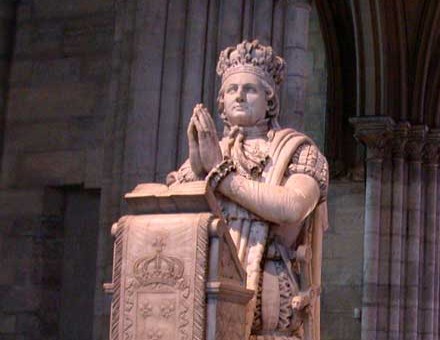
Savoy in New York
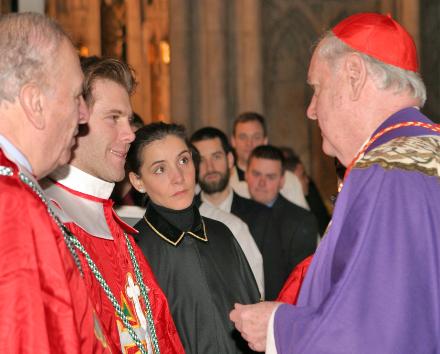
New York recently played host to the Prince and Princess of Venice and Piedmont, Emanuele Filiberto and Clotilde of the House of Savoy. Emanuele Filiberto is the son and heir-apparent of HRH Vittorio Emanuele the Prince of Naples (Vittorio Emanuele IV) who currently lives in voluntary exile from the Italian Republic. The laws forbidding the House of Savoy from visiting and living in Italy were finally overturned in 2002.
The two day visit to New York organized by the American Delagation of Savoy Orders culminated in a Solemn Mass in St. Patrick’s Cathedral on January 6 said by His Eminence Cardinal Egan, himself a Cavaliere di Gran Croce. About three dozen members of the orders of the House of Savoy attended the Mass with friends and family.
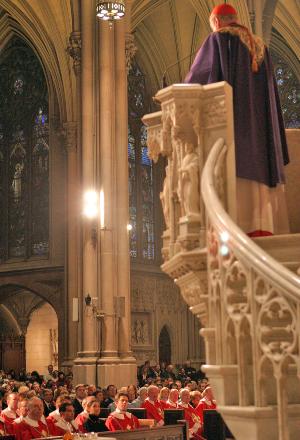
The 33rd March for Life
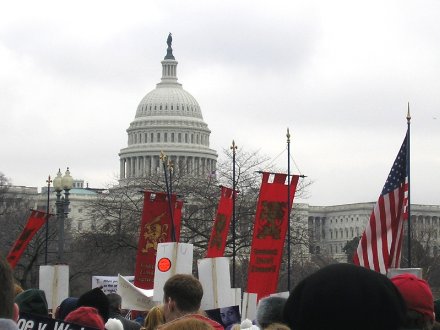
Yesterday I, and over 100,000 others, popped down to our nation’s capital for the annual March for Life held on the anniversary of Roe v. Wade. Despite the cold and passing rain, it was an event much enjoyed. I had never been to the March before, nor have I ever been to any sort of demonstration or rally of any kind for any cause. I recall, however, sitting in Canmore one day talking with the young Miss Clare Dempsey who worried over what the grandchildren of our generation might say when they look back remembering abortion and ask “What did you do to fight it?” Though it was comparitively little, waking up at 5:00 in the morning and sitting through a five-hour bus ride was a small price to pay in order to take part in the annual recollection of the devastating moment for the lives of the unborn and their mothers and fathers and family, and for our entire nation. (more…)
Peter Simple is Dead
Michael Wharton, the genius behind the Peter Simple column in the Daily Telegraph, died on Sunday at 92 years of age. Wharton was “a quietly spoken, cherubic-featured man who ate corned beef sandwiches and drank brandy and ginger ale in a Fleet Street pub every lunchtime” according to his obituary in the Telegraph which provides some background to the man who invented an imaginary realm with which to point out the faults and foibles of the real one. Here we provide some excerpts which we found particularly interesting, amusing, or explanatory.
Wharton’s first volume of autobiography, The Missing Will (1984), opened with an evocation of childhood memories: the great house, with its Long Gallery and the smooth green lawns, on the day news arrived from the Western Front that his elder brother, the Viscount, was dead. It went on to recount, however, that he was really born Michael Bernard Nathan, the son of an unsuccessful businessman of German-Jewish origins, on April 19 1913 at Shipley, in the West Riding of Yorkshire.
Young Michael was educated at Bradford Grammar School and Lincoln College, Oxford, where he learned to drink and to be idle. He took on the persona of a Tory anarchist who supported Franco and was determined to be of the Right, even if not a paid-up member. Eventually he was rusticated for throwing an egg at High Table and dismantling a sofa which was then pushed out of a window.
On the outbreak of the Second World War he joined the Royal Artillery, under his mother’s maiden name of Wharton. After obtaining a commission, he was sent to India, where he became an intelligence officer, eventually being attached to the General Staff and rising to the rank of acting lieutenant-colonel. Since the threat to India from both Germany and Japan was largely theoretical towards the end of the war, Wharton’s restless imagination came into play. He invented the Thargs, a sect of redheaded tribesmen in the Sind Desert, descendants of Alexander the Great’s soldiery who were in wireless contact with Hitler’s High Command. While studying the few facts available on some dull Japanese generals, he conjured up a one-eyed officer of the Imperial high command who had developed a fierce hatred of England after living in Harrogate where he had learnt the secret of toffee-making.
An advertisement “Learn Etruscan the Way They Did” produced a host of orders which eventually led to an announcement that the Etruscan records were sold out but that there were still stocks of Old Prussian, Aztec and Pictish; several requests inevitably followed.
The Daily Telegraph even devoted a lead editorial to Wharton’s passing, entitled ‘Death of a Genius’. God rest the soul of this brilliant and hilarious man, who provided thought and amusement for so many throughout his years.
The 7th Regiment in Washington Square
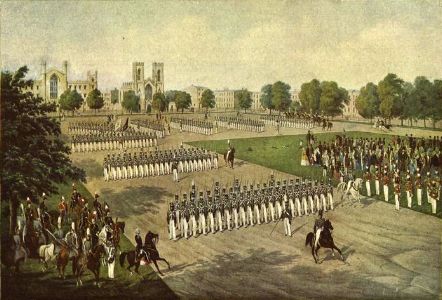
Entitled “National Guard – 7th Regiment New York State Militia”, this mid-nineteenth century view shows the famous 7th Regiment of New York, nicknamed the Silk-Stocking Regiment, parading in Washington Square. In the background can be seen the University of the City of New York and the Church of St. Thomas, which has since moved to Fifth Avenue in Midtown.
An Addendum for Union Station?
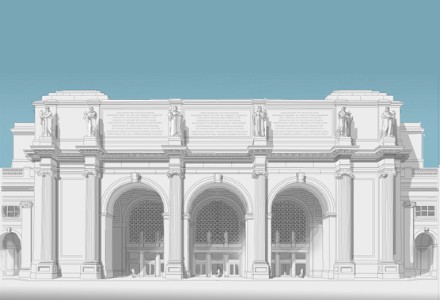
Elliott Banfield, instigated by Henry Hope Reed, has come up with an intriguing proposal to augment the façade of Washington’s monumental beaux-arts railway station. Above you can see Banfield’s illustration of Union Station as it exists today, while his view of the proposed additions can be seen below.
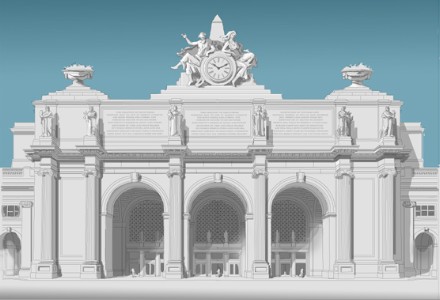
The central sculptural group are, appropriately, an allegorical depiction of Arrival and Departure. “The old man waving his goodbye, the woman, greeting,” says Banfield. “This group would be very, very big. Perhaps 40 feet high. It would be made of some sort of fiberglas material.” (View below)
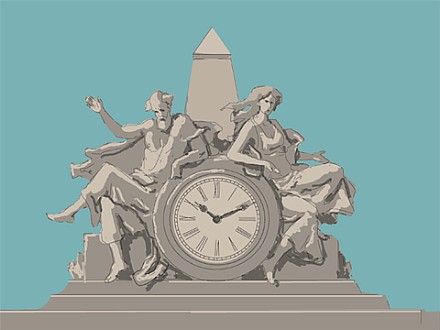
“Is this idea farfetched?” Banfield inquires. “Only to people who are bitten with the bug of historicism. To those of us who are free of that way of thinking my idea is feasible: certainly no less so than the sculptural group at Grand Central Station in New York, whch is less than a century old, and is universally accepted as a landmark.”
In the humble opinion of yours truly, the additions make the station look rather more Italianate, and I can’t decide whether that’s an improvement or a detraction. I find both the current and the posited beautiful and attractive, so I suppose while I would not oppose the change, nor would I campaign for it.
Previously: Elliott Banfield
Euthanasia Revisited
Thomas Dongan, 2nd Earl of Limerick
AS VIRGINIA, a year short of four centuries since her foundation, has only recently inaugurated her first Catholic governor, it might be an appropriate time to remember the first Catholic governor of New York, Thomas Dongan (right). Dongan’s tenure as Governor of the Province of New York was one of the most important in the history of our land, and witnessed the formative period of responsible government in what would eventually become the Empire State.
Thomas was born in 1634, the youngest son of Sir James Dongan, Bt., a Member of the Irish Parliament. After the regicide of Good King Charles in 1649, the Catholic family feared persecution and fled to France, as did the Royal Family. In France, having Gallicized his surname to D’Unguent, Thomas joined an Irish regiment and fought under the Vicomte de Turenne (who himself, born into Calvinism, became a Catholic in October 1668). Despite the Restoration of the Crown in Britain and Ireland, Dongan remained in France, being promoted to colonel in his fortieth year. The 1678 Treaty of Nijmegen, however, required all of Charles II’s subjects in the service of France to return home, and so Thomas obliged. Through the efforts of James, Duke of York, with whom Dongan had the privilege of serving in the French Army, he was granted a pension, a high-ranking commission, and was appointed Lieutenant-Governor of Tangiers, of all places, which (along with Bombay) had been given to England as part of the dowry of Catherine of Braganza.
It was in 1682 that James, Duke of York, as Lord Proprietor of New York, appointed Thomas Dongan to govern the bankrupt colony. “In this office,” the Catholic Encyclopedia says, “Dongan proved himself an able lawgiver, and left an indelible mark on political and constitutional history.” He convened the first representative assembly of the Province in 1683, which enacted the Charter of Liberties enunciating the form of government in New York. The Duke of York’s supreme legislative power as Lord Proprietor would reside in a governor, council, and general assembly. Members of the assembly were conferred rights and privileges making their august legislature coequal to and independent of Parliament. Courts of justice were established, liberty of conscience regarding religion was declared, and the principle of no taxation without representation was affirmed. Dongan signed the Charter of Liberties on 30 October 1683, and solemnly proclaimed it the next day at the Stadt Huys, New York’s city hall.
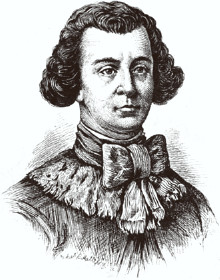 “Thus to Dongan’s term as governor,” quoth the Encyclopedia, “can be dated the Magna Charta of American constitutional liberties, for his system of government became the programme of continuous political agitation by the colonists of New York Province during the eighteenth century. It developed naturally into the present state government, and many of its principles passed into the framework of the Federal Government. Moreover, a rare tribute to his genius, the government imposed by him on New York Province, 1683, was adopted by England after the American War of Independence as the framework of her colonial policy, and constitutes the present [1909] form of government in Canada, Australia, and the Transvaal.”
“Thus to Dongan’s term as governor,” quoth the Encyclopedia, “can be dated the Magna Charta of American constitutional liberties, for his system of government became the programme of continuous political agitation by the colonists of New York Province during the eighteenth century. It developed naturally into the present state government, and many of its principles passed into the framework of the Federal Government. Moreover, a rare tribute to his genius, the government imposed by him on New York Province, 1683, was adopted by England after the American War of Independence as the framework of her colonial policy, and constitutes the present [1909] form of government in Canada, Australia, and the Transvaal.”
The peace and harmony of the Province was furthered in 1684 when Dongan, in the presence of Lord Howard, the Governor of Virginia, received the voluntary submission of the Iroquois confederacy to “the Great Sachem Charles”. The following year saw the death of Charles II and the ascent of the Lord Proprietor, James, Duke of York, to the thrones of England, Scotland, and Ireland. In that year of 1685, Dongan established a Post Office to strengthen communications within his colony and between all the English colonies in America. In the next year, 1686, the Governor granted civic charters to New York and Albany. Dongan’s charter for the City of New York lasted 135 years, while that of Albany was only replaced in 1870. Avid historians would have been bemused/irritated by Archdiocese’s celebration just a few years ago of the two-hundredth anniversary of Catholic education in New York. This would be because New York’s first Catholic school was not in the 1800’s during the republic’s early years but in the 1680’s when Governor Dongan established a college (in the secondary sense) under the guidance of three Jesuit priests, one of whom was his own private chaplain.
Despite the brief attempt to merge New York and New England, followed by the overthrow of James, our last Catholic king, in the so-called ‘Glorious Revolution’, Governor Dongan’s legacy in establishing the institutions of responsible government in New York remains. Indeed he was unquestionably New York’s greatest governor until the advent of ‘Magnus Apollo’ himself, DeWitt Clinton, in the nineteenth century. With the new Protestant Williamite administration in charge, Thomas Dongan returned to England in 1691 and, with the death of his elder brother, inherited the Earldom of Limerick under its first (1686) creation. He died in 1715, poor and childless. Nonetheless, as the Encyclopedia notes:
The tribute of history to his personal charm, his integrity, and character, is outspoken and universal. His public papers give evidence of a keen mind and a sense of humour. He was a man of courage, tact, and capacity, an able diplomat, and a statesman of prudence and remarkable foresight. In spite of the brief term of five years as Governor of New York Province, by virtue of the magnitude, of the enduring and far-reaching character of his achievements, he stands forth as one of the greatest constructive statesmen ever sent out by England for the government of any of her American colonial possessions.
The English Tower and Kavanagh Building
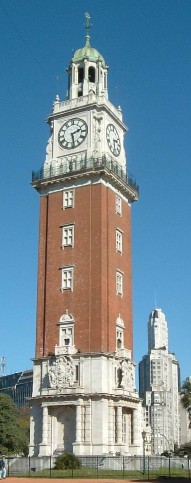 THE SAYING GOES that Argentines are all Italians who speak Spanish and want to be English, which is only just short of the truth. Whatever the quip’s verity, Argentina is a nation of the expatriated and for the centennial year of the 1810 May Revolution, the communities from each of the major mother countries — Spain, Italy, Germany, et cetera — built monuments in dedicated places both to commemorate the contributions their kinsman made to their adopted country as well as to celebrate peace and friendship between Argentina and the given motherland. The Plaza Italia, for example, lamentably bears a monument to the scoundrel Garibaldi, donated by the Italian community.
THE SAYING GOES that Argentines are all Italians who speak Spanish and want to be English, which is only just short of the truth. Whatever the quip’s verity, Argentina is a nation of the expatriated and for the centennial year of the 1810 May Revolution, the communities from each of the major mother countries — Spain, Italy, Germany, et cetera — built monuments in dedicated places both to commemorate the contributions their kinsman made to their adopted country as well as to celebrate peace and friendship between Argentina and the given motherland. The Plaza Italia, for example, lamentably bears a monument to the scoundrel Garibaldi, donated by the Italian community.
For their monumental contribution to the city of Buenos Aires, the English built a tower in the Edwardian style, rather cleverly as it was still the Edwardian period, and the depth of their cleverness was furthered by their naming it the English Tower (officially Torre de los Ingleses, or Tower of the English). Situated in the center of the Plaza Britannia (Britannia Square) at the junction of the San Martin and Libertador avenues, the Tower was designed by engineer Ambrose Poynter and built by Hopkins and Gardom completely (except for mortar) out of materials from England. Around the base are sculptural representations of the English rose, the Scottish thistle, the Welsh dragon, and the Irish shamrock. The dedication at the entrance to the Tower reads “Al Gran Pueblo Argentino. Los residentes británicos. Salud. 25 de mayo 1810-1910” or: “To the Great Argentine People, from the British residents: Salud. May 25, 1810-1910″. Towards the rear of the photo to the right you can see the Kavanagh building (Edificio Kavanagh).
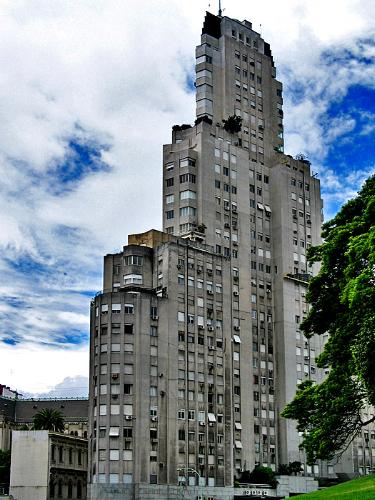
The Kavanagh building is situated on the Plaza San Martin across the avenue from the Plaza Britannia. This 29-storey apartment building was designed by the firm of Sanchez, Lagos, and de la Torre, and was the tallest building in Latin America when built in 1936. The sharp art deco design on an angulated plot is said to resemble a ship at sea, and of course Buenos Aires is a port city — its residents are called porteños after all.
The Kavanagh is unquestionably my favorite ‘modern’ building in Buenos Aires, but then modern architecture has not been kind to the city, at least not in the post-war period (c.f. the National Library). The structures built in the 1950’s were only drab and dull whereas the 60’s and 70’s bore the ill fruits of the ‘lets see how many things we can do with concrete’ trend and tended towards the insidiously hideous rather than the mundane. But no matter however irritating these later obtrusions are, at least Buenos Aires still has the Kavanagh.
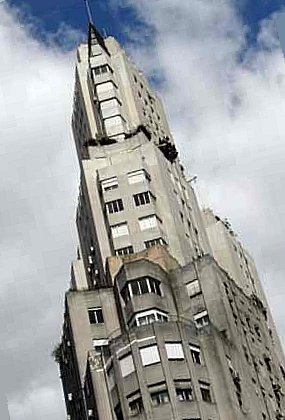
Despite the generations of immigration, investment, interbreeding, and cultural interchange, relations between Argentina and Great Britain were somewhat marred, shall we say, by the shameful attempt by the unhinged wing of the Argentine military to annex the Falklands and rename every geographical feature therein (seriously, I’ve seen the maps). When they were done renaming everything in the Falklands (or ‘Malvinas’ as they would have us believe) the craze apparently spread homewards to the capital. The Plaza Britannia was renamed the Plaza Fuerza Aerea Argentina (from Britannia Square to Argentine Air Force Square), while the Torre de los Ingleses was rechristneed the more ambiguous Torre Monumental. In an even more unfriendly move, the Memorial to the Fallen of the ‘Malvinas’ was built in Plaza San Martin facing the English Tower across the street. In the spirit of peace and friendship, especially regarding two countries which have such deep links as Britain and Argentina, the Memorial really ought to be removed and placed in some other suitable location in the city. Until that time, it remains the Plaza Britannia in my books, and as for the ‘Malvinas’, no such place exists.
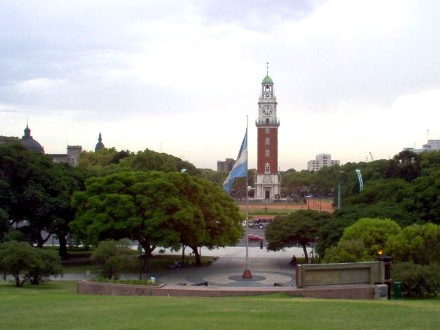
The ‘Malvinas’ memorial viewed from the rear, with the English Tower across the Avenue.
The World of Law


Today I stumbled upon this nifty little map (slightly modified) on Wikipedia showing the different legal systems of the world. (Click on the map above for the full version). Civil law is predominant, but of course Common Law is the best, and happens to predominate throughout the English-speaking world. Four economists have also claimed that economic prosperity and the common law system are linked. As one can see from the map, Scotland does not share the same legal system as the rest of the United Kingdom but instead has its own unique system of law, the maintenance of which was stipulated in the 1707 Treaty of Union uniting Scotland and England.
The Wikipedia article on Common law has a paragraph on New York law, which interestingly states:
To be specific, the patroon system ended along with the later manorial courts originating from the British period when New York abolished these psuedo-feudal law features in 1849. Scarsdale, the neighboring municipality to the north of here, is supposedly the last manor granted in the British Empire and recently celebrated the three-hundredth anniversary of the 1703 grant. There were a number of other manors granted in New York, such as Fordham and Pelham nearby. The City of New Rochelle consists of land purchased by the Huguenots from Thomas Pell. One of the stipulations was that New Rochelle would present Pell and his successors with a fatted calf every year on St. John’s Day (if my memory serves me correctly). I understand the practice was continued into the 20th century before sadly lapsing.
Meanwhile, some Europeans are catching on to the fact that the Supreme Court of the United States has usurped legislative powers contrary to the Constitution. The Chancellor of Austria and Prime Minister of Denmark are worried that the European Court of Justice might be tempted to do the same, and Paul Belien offers his thoughts at the Brussels Journal.
The Basis of Peace is Truth
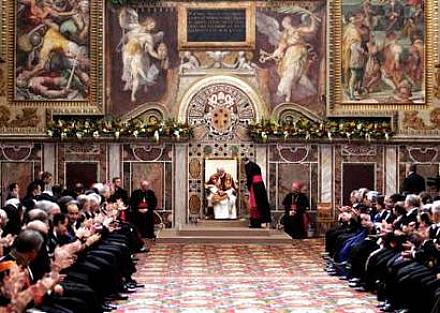
Yesterday morning the Holy Father addressed the corps of diplomats accredited to the Holy See. The address was given not his native German, nor the Church’s Latin, nor in the vernacular Italian, but rather in French being the language of diplomacy. The entirety of the Pope’s remarks is posted over at Whispers in the Loggia.
The New PMC
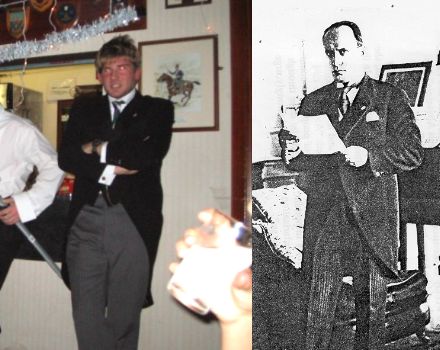
At left: The newly-elected PMC, A Sqn TUOTC, Scotland, 2005. At right: The newly-elected Prime Minister, Italy, 1922. An intriguing juxtaposition.
Though I am still Stateside, I should like extend our slightly belated congratulations to J.E.B., Esq., whom Tom Marshall has described as “the greatest potential cavalryman since Harry Flashman”, on his election to the Presidency of the Mess Committee this past December. Mr. J.E.B. is something of a legend in the Auld Grey Toon and the Mess will benefit from his profound wisdom, not to mention his lack of affection for bad music. A pipe smoker, J.E.B. is the donor of the Mess’s engraved pipe rack which rests on the mantel below the portrait of Her Majesty.
(Photos courtesy of Miss K. Dilworth)
Epiphany
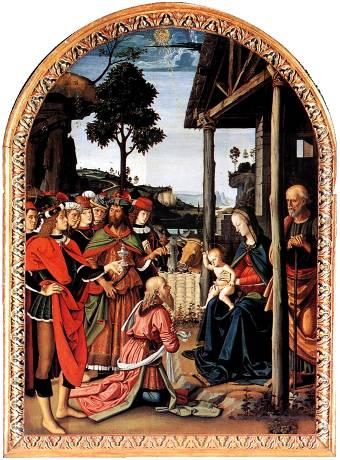
Pietro Perugino, Adoration of the Kings (Epiphany)
Oil on panel, 95′ x 70′
c. 1476, Galleria Nazionale dell’Umbria, Perugia
St. John Nepomuk Neumann
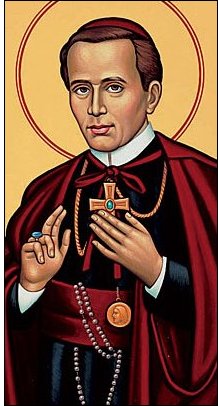 TODAY IS THE feast of St. John Neumann, the saintly Bishop of Philadelphia. St. John was born to a Czech mother and German father in Prachatice (Prachatitz), Bohemia and attended the Charles University in Prague with the intention of being ordained to the priesthood. His bishop, however, decided against any new ordinations as there were too many priests in Bohemia already (Just imagine!). John, fluent in six languages, wrote to other bishops in Europe seeking ordination until he decided to appeal to the episcopacy of the United States. He became the first Redemptorist in the New World when he took his vows in Baltimore in 1842. Six years later he became an American citizen, and just ten years later he was consecrated Bishop of Philadelphia.
TODAY IS THE feast of St. John Neumann, the saintly Bishop of Philadelphia. St. John was born to a Czech mother and German father in Prachatice (Prachatitz), Bohemia and attended the Charles University in Prague with the intention of being ordained to the priesthood. His bishop, however, decided against any new ordinations as there were too many priests in Bohemia already (Just imagine!). John, fluent in six languages, wrote to other bishops in Europe seeking ordination until he decided to appeal to the episcopacy of the United States. He became the first Redemptorist in the New World when he took his vows in Baltimore in 1842. Six years later he became an American citizen, and just ten years later he was consecrated Bishop of Philadelphia.
St. John Neumann built ninety-eight schools, fifty churches, and began construction on a cathedral, as well as writing two catechisms. His earthly remains are on view in Philadelphia to this day.
Old Dominion, New Mace
THE HOUSE OF DELEGATES OF THE COMMONWEALTH OF VIRGINIA
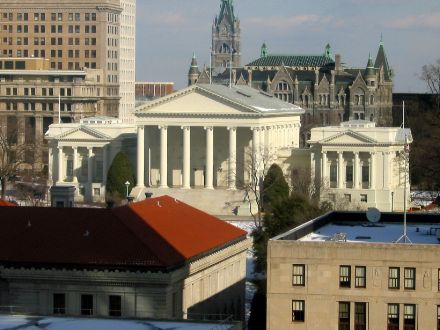
VIRGINIA IS THE birthplace of Anglo-America, and as such it has managed to maintain higher standards of propriety than most other places in the States, including its long-time rival, New England. Governors, for example, still wear morning dress for their inaugurations rather than the lamentable business suit which has usurped events even so high and mighty as the inauguration of the President of the United States. (Carter abolished morning dress for the inauguration, Reagan wore it  for his first with a stroller instead of tailcoat, but since then it’s been suits all around). Roger Scruton, Britain’s greatest living Conservative thinker, recently moved with his family to Virginia to enjoy the fruits of American freedom since one of his favorite pasttimes, outlawed back in the Mother Country, thrives in his new home. The origin of Virginia’s traditional nickname, ‘the Old Dominion’, is from King Charles II who granted the Colony that title of Dominion as a recognition of its steadfast loyalty to the Crown during the trying days of the Interregnum.
for his first with a stroller instead of tailcoat, but since then it’s been suits all around). Roger Scruton, Britain’s greatest living Conservative thinker, recently moved with his family to Virginia to enjoy the fruits of American freedom since one of his favorite pasttimes, outlawed back in the Mother Country, thrives in his new home. The origin of Virginia’s traditional nickname, ‘the Old Dominion’, is from King Charles II who granted the Colony that title of Dominion as a recognition of its steadfast loyalty to the Crown during the trying days of the Interregnum.
Some traditions, however, have been mournfully discontinued. Virginia’s House of Burgesses was the first legislative body in the New World but its name was changed to the House of Delegates during the Revolution. (North Carolina, meanwhile, kept its House of Commons until it was defeated by the United States in the Civil War). Nonetheless, the House sat in the antiphonal pattern akin to the British and Commonwealth parliaments until 1904 when it adopted the dastardly French republican semicircular seating plan. To my knowledge, it was the last American legislature (outside of Canada, of course) to arrange its seating in the traditional way. (more…)
Search
Instagram: @andcusack
Click here for my Instagram photos.Most Recent Posts
- Burns Tower April 19, 2024
- Patrick in Parliament March 18, 2024
- Articles of Note: 13 March 2024 March 13, 2024
- Cambridge March 9, 2024
- Taken on Trust March 4, 2024
Most Recent Comments
Book Wishlist
Monthly Archives
Categories

